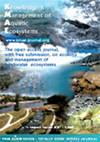用声学相机(ARIS)原位评估欧洲鳗鱼数量和长度估算精度
IF 1.7
3区 环境科学与生态学
Q3 FISHERIES
引用次数: 11
摘要
尽管在鱼类生态学和渔业研究中越来越多地使用声学相机,但与该方法相关的偏差量化却很少受到关注。在这篇文章中,我们使用了从ARIS声学摄像机收集的数据,该摄像机安装在连接泻湖和海洋的通道上,量化了欧洲鳗鲡(Anguilla Anguilla)数量的差异,并由两位经验丰富的操作员进行了大小估计。从58个视频中得出的计数估计在两个算子之间高度一致(R2 = 0.99),尽管在统计上存在差异。与已知的82条鳗鱼的尺寸相比,人工从视频中估计的尺寸被低估了。两种操作人员的平均误差百分比差异显著(- 3.9%±8.5 (SD)和- 6.6%±8.9)。该误差百分比受已知鳗鱼大小的显著影响,而不受检测范围的影响。我们的研究结果强调了在基于声学相机的鱼类生态学和渔业研究中考虑到数量和大小估计偏差的重要性。当多个操作员分析声学视频或比较不同研究的结果时,必须对这些偏差进行量化,如果可能的话,使用本研究中描述的类似协议进行纠正。本文章由计算机程序翻译,如有差异,请以英文原文为准。
In situ evaluation of European eel counts and length estimates accuracy from an acoustic camera (ARIS)
Despite the increasing use of acoustic cameras in fish ecology and fisheries studies, the quantification of biases associated with this method have received little attention. In this note, we used data collected from an ARIS acoustic camera, positioned in a channel linking a lagoon to the sea, to quantify differences in European eel (Anguilla anguilla) counts and size estimates made by two experienced operators. Count estimates made from 58 videos were highly consistent between the two operators (R2 = 0.99), although statistically different. Compared to the known sizes for the 82 eels, sizes estimated manually from video were underestimated. The resulting mean error percentages were significantly different between the two operators (−3.9% ± 8.5 (SD) and −6.6% ± 8.9). This error percentage was significantly influenced by the known size of the eels but not by the detection range. Our results highlighted the importance of taking into account the biases in counts and size estimates in fish ecology and fisheries studies based on acoustic cameras. These biases have to be quantified and, if possible, corrected using similar protocols as described in this study, when multiple operators analyse acoustic videos or when comparing the results from different studies.
求助全文
通过发布文献求助,成功后即可免费获取论文全文。
去求助
来源期刊

Knowledge and Management of Aquatic Ecosystems
环境科学-海洋与淡水生物学
CiteScore
3.70
自引率
5.60%
发文量
22
审稿时长
>12 weeks
期刊介绍:
Knowledge and Management of Aquatic Ecosystems (KMAE-Bulletin Français de la Pêche et de la Pisciculture since 1928) serves as a foundation for scientific advice across the broad spectrum of management and conservation issues related to freshwater ecosystems.
The journal publishes articles, short communications, reviews, comments and replies that contribute to a scientific understanding of freshwater ecosystems and the impact of human activities upon these systems. Its scope includes economic, social, and public administration studies, in so far as they are directly concerned with the management of freshwater ecosystems (e.g. European Water Framework Directive, USA Clean Water Act, Canadian Water Quality Guidelines, …) and prove of general interest to freshwater specialists. Papers on insular freshwater ecosystems and on transitional waters are welcome. KMAE is not a preferred journal for taxonomical, physiological, biological, toxicological studies, unless a clear link to ecological aspects can be established. Articles with a very descriptive content can be accepted if they are part of a broader ecological context.
 求助内容:
求助内容: 应助结果提醒方式:
应助结果提醒方式:


